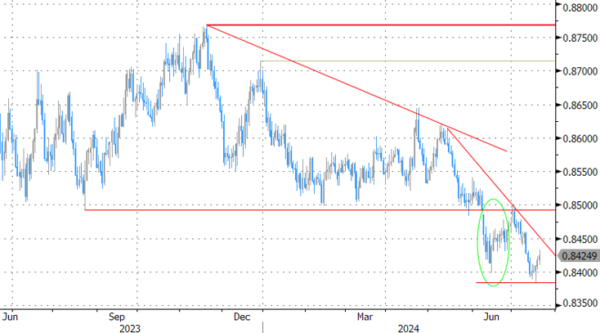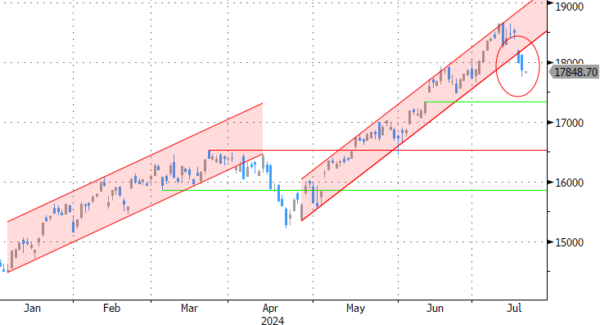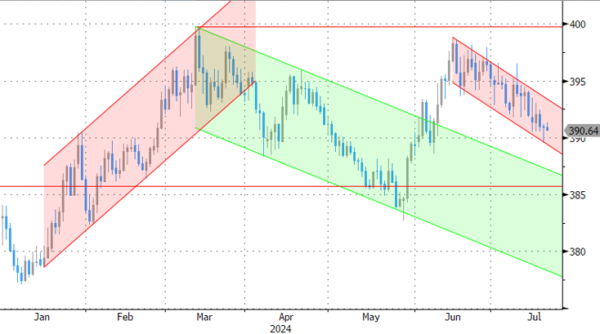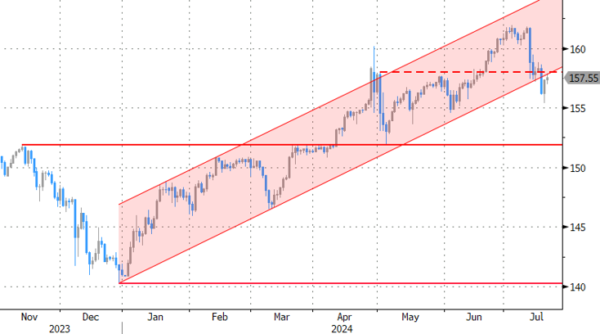Markets
One of the biggest-ever IT outages sparked volatility at the start of European trading but without lasting impact on general markets. A security update by CrowdStrike caused a global problem with Microsoft’s Windows. UK retail sales also printed at the onset of trading and failed to settle the debate on the outcome of the August BoE policy meeting. Recall that it only needs a change of heart at a few MPC-members to pull the trigger on an August policy rate cut. This week’s inflation figures and labour market data slightly argued in favour of waiting another month whereas retail sales point into the direction of immediate action. EUR/GBP moved further away from the 0.84 support zone, changing currently hands around 0.8425. Today’s agenda was empty afterwards, allowing us to focus on ECB comments following yesterday’s indecisive policy meeting. ECB Muller finds it hard to comment on how many rate cuts there will be this year. ECB Villeroy was more willing to show his cards, suggesting that market expectations on rates (quarterly 25 bps moves in September/December/March/June) seem rather reasonable. ECB Simkus warned on the strength of services inflation but also agrees with the market view for two more cuts this year. ECB Rehn was neutral, not willing to commit to any rate-path. It’s clear that July and August CPI figures and Q2 wage data will in the end decide on the near term ECB policy rate path.
European stock markets lost around 0.5% in the open, catching up with WS losses, but held stable afterwards. The dollar is going nowhere at EUR/USD 1.0890. Core bonds face somewhat more selling pressure, as the ISM/CPI rally is running out of steam. Daily changes on the US yield curve currently range between +2.5 bps and +3.5 bps. German yields increase by 1.5 bps to 3.8 bps in a steepening move. Markets likely entered some kind of lull in the run-up to the July 31st FOMC meeting. More and more gossip on a Biden withdrawal in the US presidency race for now leaves no traces on markets neither.
News & Views
The ECB Survey of Professional Forecasters for Q3 2024 only showed modest changes compared to the Q2 outlook. Respondents expect headline HICP inflation to decline from 2.4% in 2024 to 2% in 2025 and further to 1.9% in 2026 (unchanged apart from a 0.1 ppt downward revision for 2026). Longer-term inflation expectations were unchanged at 2%. Expectations for core inflation (ex-energy and food) were revised upwards slightly for 2024 (2.7% from 2.6%) and 2025 (2.2% from 2.1), reflecting data outturns and more persistent than expected services inflation and labour cost growth. Expected real GDP growth for 2024 remained modest at 0.7%, reflecting mainly a weak carry-over from 2023, but was revised upwards due to a stronger than expected Q1 2024 outturn. Expectations for 2025, 2026 and the longer term were 1.3%, 1.4% and 1.3% respectively (unchanged apart from a 0.1 ppt downward revision for 2025). Respondents expect the unemployment rate to increase to 6.5% in 2024 but to decline gradually to 6.4% in 2026 and then remain at 6.4% in the longer term, implying a slight downward revision to the profile of the unemployment rate. Expectations for annual growth in compensation per employee were revised upwards by 0.5 ppts for 2024 and 0.2 ppts for 2025, to 4.5% and 3.4% respectively. These revisions were explained by stronger than expected outcomes, increases in public sector wages and in minimum wages in some countries, plus more persistence looking ahead than previously expected.
Looking forward to next week’s policy meeting of the National Bank of Hungary (MNB), KBC economics expects that there is room for a next 25 bps rate cut, even as the MNB announced that it had entered a new era for monetary policy, applying a more cautious month-by-month approach. However, this week vice-governor Virag indicated that a July rate cut remains completely open depending on incoming data. He expects inflation likely to remain around the tolerance band in the second half of the year and beliefs inflation could stay closer to 4% rather than 5% expected by some. This still requires a tight and prudent policy with an appropriate level of real interest rates. With inflation currently near/below 4% (3.7% headline, 4.1% core), he sees 2 or 3 rate cuts by the end of the year as realistic. The MNB might also positively assess recent fiscal consolidation measures announced by the government. A recent decline in market interest rates and the forint strengthening to near EUR/HUF 390 could give the MNB some comfort as well. After a 25 bps rate cut to 6.75% next week, KBC sees an end of year policy rate of 6.25% with next steps September and December.
Graphs
EUR/GBP: markets remain in doubt on outcome of August policy meeting. Too early to frontrun on break below 0.84

Nasdaq: IT-outage adds to current correction momentum

EUR/HUF: forint doesn’t bother MNB intentions to restart easing cycle before it even really stopped

USD/JPY: Japanese June inflation data rise, though slightly less than feared. We don’t think it will stop the BoJ from implementing a rate hike at the July 31 meeting










